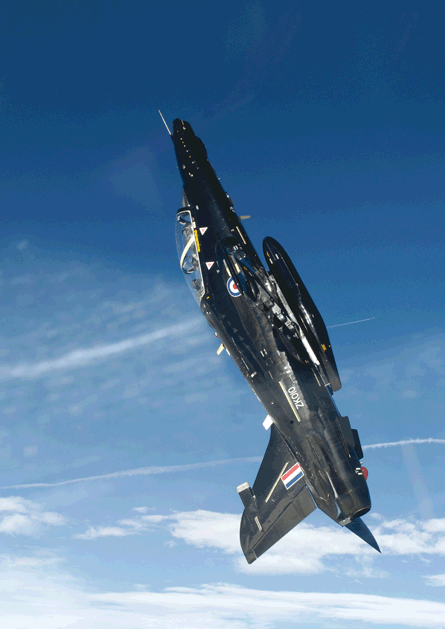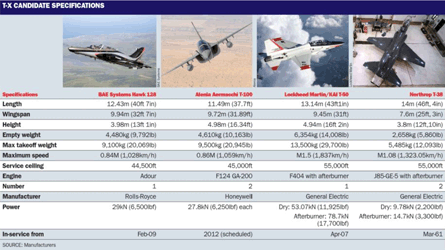 |
|---|
© BAE SystemsThree off-the-shelf trainers made abroad are being considered, including the Hawk |
Next month, the US Air Force is scheduled to validate a strategy that - if funded - could lead to the rapid development and fielding of hundreds of jets, replacing the aging supersonic Northrop T-38C Talon with a new advanced "T-X" trainer optimised to support fifth-generation fighters.
The scheduled meeting of the air force requirements oversight council in March is coincidentally timed near the 50th anniversary of the T-38's entry into service. The T-38 was introduced at a time when the USAF needed a lead-in trainer to support the third generation of fighter jets - namely, the McDonnell Douglas F-4 Phantom II - and remained relevant with the arrival in the 1970s of the Boeing F-15 and Lockheed Martin F-16.
"The T-38 is a classic airplane and its function that it's performed in air training has been absolutely phenomenal," says Brig Gen Chris Nowland, director of planes, programmes, requirements and assessments for the Air Education and Training Command (AETC).
"It was designed for 7,000 flight hours. The average in the fleet is 15,000h," Nowland explains. "When you think about how many landings ... Clearly, there are sustainment pressures on keeping the airframe going."
With the advent of an operational, fifth-generation fighter force in 2005, however, even a modernised T-38C fleet began showing its age. Before climbing into the cockpit of an F-22, USAF pilots must train in the F-16, even after learning basic skills in the T-38C.
Fielding a modern replacement should allow aspiring F-22 (and, soon, F-35) pilots to move directly from the T-X aircraft and simulator into a fifth-generation fighter. But it is not just about the fifth-generation fighters, says Nowland, who started flying F-15Cs in the early 1990s. "The F-15C has new radars, helmet-mounted sight, AIM-9X and fighter data link," he says. "That's a fundamentally different airplane than when I started flying it."
PACE OF CHANGE
Modern trainers have also changed dramatically since the T-38 arrived in the early 1960s. An analysis of alternatives being finalised shows the competitive field's breadth.
An AETC team visited five different locations. In Long Island, NY, the team received a briefing from Northrop, which can propose a T-38 remanufacturing programme. Boeing has investigated several options, including a trip to Argentina to evaluate the IA-73 trainer. But it is believed that the AETC team visiting St Louis was briefed on a purpose-built, clean-sheet design for a Boeing-made trainer.
In addition, the USAF can choose from any of three off-the-shelf trainers manufactured abroad. The AETC team duly paid visits to the KAI/Lockheed Martin T-50 assembly line in Korea, the BAE Systems Hawk 128 plant in Salmesbury, UK, and Alenia Aermacchi's Venegono, Italy site, where it makes the M-346 - branded the T-100 for T-X purposes.
 |
|---|
Click for full size version |
Despite the plethora of options, the future viability of the T-X programme, which also includes plans to buy dozens of the most state-of-the-art simulators, still remains uncertain.
For funding, existing plans require spending hundreds of millions to start fielding a replacement by 2017, yet no budget planning documents support such a strategy. For the next four years, the USAF has allocated only $30 million to T-X; not nearly enough to award a development contract in that timeframe.
But the USAF's funding profile was introduced as a placeholder. The Pentagon's Fiscal 2011 budget request, submitted to the US Congress last February, identified T-X as a "new-start", but provided only token funding. The programme was on the books, but the USAF had not studied the market or crafted an acquisition strategy.
In fact, the only public study of the USAF's trainer fleet had done the opposite. In a 2005 paper authored by the RAND Corporation, a majority of AETC officials predicted the T-38C would be sufficient to support the training needs of fifth-generation fighters. Since the RAND study, however, a series of crashes in 2008 raised fresh concerns about the T-38C fleet's long-term viability as a safe trainer. The AETC launched a structural upgrade to ensure the T-38C would remain safe to operate beyond 2020, but the lesson was learned. The start of the fleet's retirement was moved to 2017. Still, holding to that schedule could prove difficult. With no funding expected to launch the programme in the 2012 financial year, a competitive acquisition process is not likely to begin until the next year. Selecting a contractor could take another two years, leaving only two to three years at most to field an operational unit by financial year 2017.
UNMOVING TARGET
Despite the challenging schedule, AETC officials have not backed off the 2017 target for initial operational capability of a future T-X fleet. Addressing the AETC convention in San Antonio, Texas, in January, Nowland reaffirmed plans to achieve IOC within six years. "When you think how many landings that the T-38 fleet has had, clearly there are sustainment pressures on keeping that airframe going," Nowland told Flight International.
The AETC also wants to move on to the next generation of trainers. Both the F-22 and F-35 are limited to single-seat cockpits, which increases the pressure on the training system to prepare pilots. Although pilots currently need to spend time in the F-16 as a bridge to the F-22, that process may not be practical as hundreds of F-35s arrive. The T-X fleet must allow pilots to complete the AETC's introduction to fighter fundamentals (IFF) course, then move straight to a fifth-generation fighter cockpit. "The future would consist of basically going straight from T-X into IFF and then straight into F-22 and F-35," Nowland says.
Obtaining a new aircraft with those capabilities depends on the acquisition strategy that is settled on during the AFROC meeting next month. The strategy must then be validated by the Joint Requirements Council in a meeting of the Defense Acquisition Board in the third quarter. But it will be critical for the USAF to manage the source selection process in a manner that avoids the acquisition blunders of the past. Contracts awarded by the USAF for new tankers and search-and-rescue helicopters have been overturned thanks to procedural errors in the selection process.
Nowland says the AETC is aware of that history, and does not want to make the same mistakes. "We are working very hard with our acquisition brethren to make sure this programme is done correctly," he says. "We make sure we partner with industry where it's appropriate to partner with industry."
- For commentary on the latest developments in US defence, visit Flightglobal's DEW Line blog
Source: Flight International























